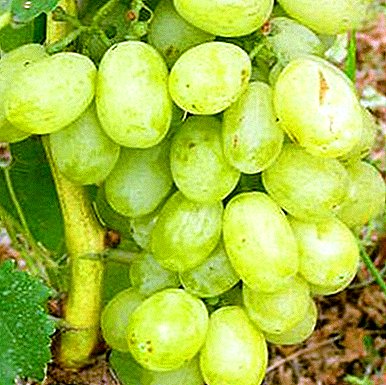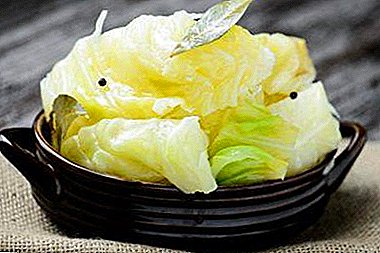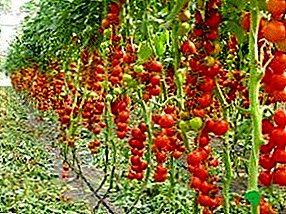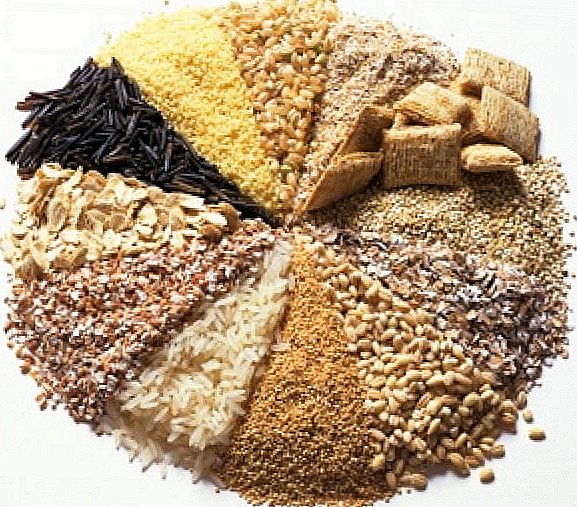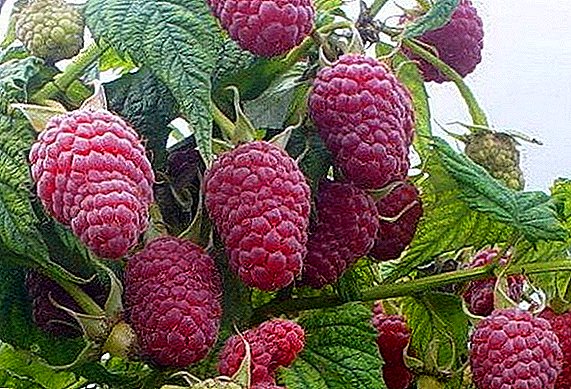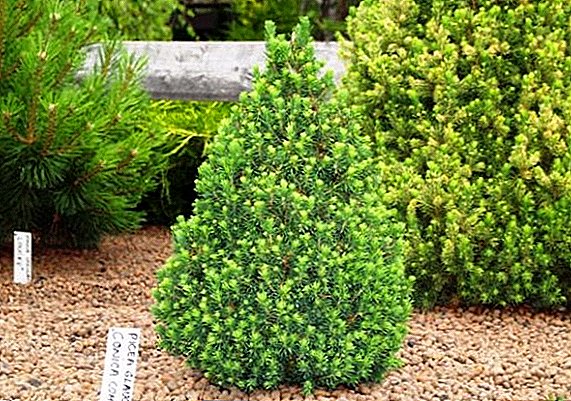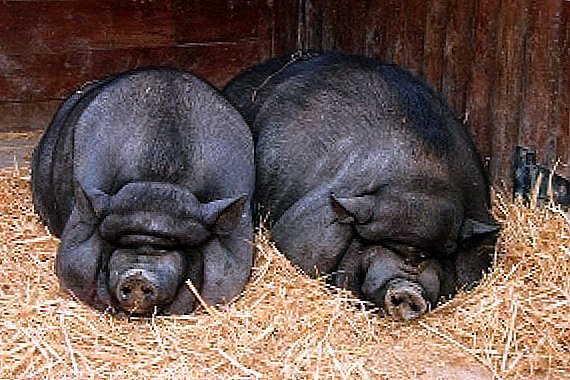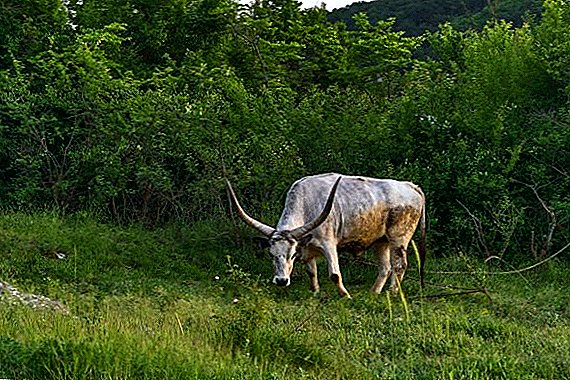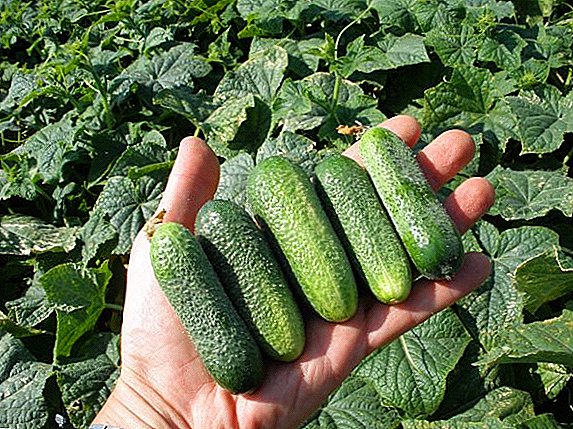 Early ripening green flow F1 cucumbers are popular with many gardeners and even hit the ranking of the best varieties. Hybrids have good fruiting, as well as suitability for canning. They can be cultivated both in the greenhouse and in the open field. How to grow crisp Zelentsy on your site, how demanding the variety is for the conditions and whether it is possible to increase its yield - we'll talk about all this later in the article.
Early ripening green flow F1 cucumbers are popular with many gardeners and even hit the ranking of the best varieties. Hybrids have good fruiting, as well as suitability for canning. They can be cultivated both in the greenhouse and in the open field. How to grow crisp Zelentsy on your site, how demanding the variety is for the conditions and whether it is possible to increase its yield - we'll talk about all this later in the article.
Variety description
The variety was born thanks to the efforts of the Moscow breeders Igor and Stanislav Dubinins, as well as Andrey Lukyanenko. Its main purpose is open beds or temporary film shelters. After all, the hybrid is characterized by increased endurance to weather conditions, diseases and pests, and is also characterized by abundant fruiting.
Did you know? Cucumbers spread throughout the world from Asia. Until today, these plants grow wild in the Himalayan mountains.
According to gardeners who have already dealt with a hybrid, Green Stream is a magic wand that you can rely on in a lean year or in the frosty spring.  The botanical features of these parthenocarpic cucumbers lie in their suitability for spring, summer and autumn circulation. From the moment of emergence of seedlings until the ripening of the greens, no more than 45 days pass.
The botanical features of these parthenocarpic cucumbers lie in their suitability for spring, summer and autumn circulation. From the moment of emergence of seedlings until the ripening of the greens, no more than 45 days pass.
Taking into account the fact that the vines are highly developed upwards, experts advise using a trellis during cultivation. The plant is medium sized and well tolerates the pinching of the lateral processes. The foliage on the bush is emerald green, medium size.
Among other positive qualities of the variety, one can not fail to note the high vitality. Pletni not afraid of powdery mildew, or the vagaries of weather, no shade, or drought. Moreover, according to gardeners, the hybrid is more resistant to pest attacks than other counterparts.  But to teach a good harvest is impossible, planting quality seedlings, forget about it before the fruits. The culture is very moisture-loving, so throughout the growing season will require abundant watering. It is important not to overdo it, because a significant drawback of the variety is the sensitivity of the roots to putrefactive infections.
But to teach a good harvest is impossible, planting quality seedlings, forget about it before the fruits. The culture is very moisture-loving, so throughout the growing season will require abundant watering. It is important not to overdo it, because a significant drawback of the variety is the sensitivity of the roots to putrefactive infections.
Important! Harvest from the Green Stream is best collected when the fruit grows in length no more than 45 centimeters. In overdue form, they greatly thicken, turn yellow and become tasteless. Consider that cucumbers of 20-25 centimeters in size possess the best taste.
Fruit characteristics and yield
Fruits are characterized by an elongated cylindrical shape, weak ribbing, medium tuberculosis and excellent taste. On one plant can be at the same time up to 5 fruits. Moreover, the period of continuous fruiting lasts until the snow. On average, each cucumber grows in length to 30-50 centimeters and weighs about 300 grams. A characteristic feature of the variety is a long fruit stem.  The entire harvest of the Green Stream is distinguished by a thick skin, on which are visible thin white strokes, medium dense pile and prickly whitish thorns. Cucumber pulp captivates not only a rich pleasant aroma, crunch, but also a delicate, slightly sweet taste. It is characteristic that at any time and weather it does not feel the bitterness typical of other varieties.
The entire harvest of the Green Stream is distinguished by a thick skin, on which are visible thin white strokes, medium dense pile and prickly whitish thorns. Cucumber pulp captivates not only a rich pleasant aroma, crunch, but also a delicate, slightly sweet taste. It is characteristic that at any time and weather it does not feel the bitterness typical of other varieties.
Did you know? Napoleon Bonaparte loved fresh cucumbers. And the French emperor promised a good reward to someone who would figure out how to preserve the freshness of the fruit over long military campaigns.
With the cultivation of the culture in the open field with each square meter can collect up to 7 pounds of high-quality fruits. Slightly lower yields will be in apartment conditions, but the variety will not disappoint you, even growing on the balcony. After all, one fruit is enough to make a salad for the whole family.  And if your plans include winter harvesting, you can experiment. Experienced housewives recommend a hybrid in a lightly salted variation, and for canning, it is advisable to choose other varieties. Although we note that in a preserved form, "Green Stream" does not lose its flavor and crunch. Simply, it is inconvenient because of the size of Zelentsy.
And if your plans include winter harvesting, you can experiment. Experienced housewives recommend a hybrid in a lightly salted variation, and for canning, it is advisable to choose other varieties. Although we note that in a preserved form, "Green Stream" does not lose its flavor and crunch. Simply, it is inconvenient because of the size of Zelentsy.
Selection of seedlings
Quality seed and seedlings are half the success in gardening. Therefore, in order not to make a mistake when choosing, one should mainly be guided by standards that guarantee a good survival rate of plants and high yields.  Here that experienced hostesses recommend it:
Here that experienced hostesses recommend it:
- First of all, it is important to determine where the desired plant will grow. If you need seedlings for the greenhouse, the preferences are given to the senior specimens. For early fruiting, they can already be rooted in the second decade of April and in the first weeks of May. For unheated film constructions, young shoots should be selected and planted not earlier than mid-May. And in the open garden beds, the younger seedlings will take root best.
- Keep in mind that cucumbers in normal development in 30 days should reach a height of 25-30 centimeters. Stems by this time thicken to 0.6-1 cm. White pimples are clearly visible on the semi-clenched knee, which reaches 5 centimeters. These are the rudiments of roots.
- Quality planting material is always characterized by a strong root system, a durable, viable stem and dark green foliage.
- Special attention should be paid to the number of young leaf blades. On a 30-day-old seedling there should be about 5-6 (each with a diameter of up to 20 cm).
- Often on sale appear specimens with strongly elongated thin stems and pale underdeveloped foliage. Such specimens should not be bought, since they will be stunted and sore due to lack of light and violations of growing technologies.
- The root system of a good seedling always has a pleasant aroma and completely surrounds the whole earthen room. It must be different powerful shoots. Pots in which plants are sold must be intact and without cracks. Do not think that the roots sticking out of the pallet testify to the good quality of the sprouts. In practice, most of the elongated shoots breaks off during transplantation. A good sign is the viewed roots on the container walls. They indicate the proper development of the plant. If we are talking about potless seedlings, carefully study the root system for rot, mildew, signs of vital activity of pests, suspicious thickenings.
- The foliage needs to be examined both from external, and from the back. Indeed, often sucking parasites can settle between the veins. Deformed or too wrinkled leaflets indicate viral infections. But excessive greens on the leaves and twisted down the edges indicate an excess of nitrogen. This usually happens when the seller is trying to accelerate the vegetation of the stems by using intensive fertilizing and watering, pushing it for sale.

Soil and fertilizer
Growing cucumbers of any kind requires preliminary soil preparation. It usually begins in the fall. To this end, for each square meter you need to make about 3 buckets of humus, 4 cups of sod land and 100 g of nitrophoska. If you ignore these activities, in the summer period you will have to constantly feed the culture.
Did you know? In ancient Egypt, it was taken in the tomb of the Pharaohs to put cucumbers. It is characteristic that these vegetables were along with gold and other jewels.
With the onset of spring heat, the bed is dug up to a depth of 20 cm, and a 15-cm layer of fertile soil is laid on top. It is important to carefully level the area, providing channels for irrigation. Then the prepared site is covered with a polyethylene film for heating.  Preparing the soil for planting If the planting season has started and the garden has not been prepared, it is necessary at least a couple of weeks before planting to fill in a section of wood ash (2 tablespoons per square meter) and superphosphate (1 cup). Top add a bucket of old sawdust and humus.
Preparing the soil for planting If the planting season has started and the garden has not been prepared, it is necessary at least a couple of weeks before planting to fill in a section of wood ash (2 tablespoons per square meter) and superphosphate (1 cup). Top add a bucket of old sawdust and humus.
Agree, timely introduction of fertilizers will provide high yield. Read how to properly feed cucumbers with yeast, iodine, and also read the best tips on feeding cucumbers in a greenhouse.
After digging the soil can be poured over with sodium humate at the rate of 3 liters per square meter. The working solution is prepared by dissolving 1 tablespoon of the drug in 10 liters of water. Then the bed of 3-4 days should warm up under the film.
However, if you choose the wrong place to achieve the desired fruiting will not succeed. Therefore, when planning planting, set aside a well-lit area for cucumbers with loose sandy or loamy soil. This culture is very sensitive to alkaline and acidic substrates. For her comfort it is necessary that the pH level was 7 (neutral).  Determination of soil acidity with special devices If this value is less, it will be necessary to deactivate the area with lime, cement dust, dolomite flour, ash, defecation or ordinary old plaster.
Determination of soil acidity with special devices If this value is less, it will be necessary to deactivate the area with lime, cement dust, dolomite flour, ash, defecation or ordinary old plaster.
We advise you to consider the importance of soil acidity for plants, how to determine the acidity of the soil and how to deoxidize the soil.
You can check the acidity of the soil at home by using litmus paper or using the old-fashioned method, where the indicator is weeds growing on the ground. On oxidized soils they prefer to grow: horsetail, pikulnik, horse sorrel, mint, wood lice, heather, plantain. And like a neutral or slightly oxidized environment: wheatgrass, chamomile, clover, coltsfoot, creepers.
Important! Pumpkin and zucchini are bad predecessors for cucumbers. It is best to plan on-site planting potatoes, cabbage and early onions.
Growing conditions
The variety "Green Stream", like other members of the genus, requires a lot of light, moisture and heat on the garden. These are the main conditions under which the culture will feel comfortable.  It is important that the hedge be given plenty of light. After all, the hybrid is characterized by many flowers of the female type. With an ultraviolet deficit, the ovary will begin to crumble. Although breeders maximally adapted it to the shade, but in such conditions the plant will develop poorly. Therefore, cucumbers are planted away from trees, buildings and tall garden crops.
It is important that the hedge be given plenty of light. After all, the hybrid is characterized by many flowers of the female type. With an ultraviolet deficit, the ovary will begin to crumble. Although breeders maximally adapted it to the shade, but in such conditions the plant will develop poorly. Therefore, cucumbers are planted away from trees, buildings and tall garden crops.
You will be interested to get acquainted with the most unusual methods of growing cucumbers: in plastic bottles, bags, buckets, barrels and hydroponics.
It is unacceptable that the bed was thickened. Then only the central shoot will develop, depriving the nutrition of the fertile lateral processes. In addition, close proximity will lead to diseases and early aging of vines.
For abundant fruiting, the optimum temperature is recommended within + 22-26 ° С. If the thermometer drops below 14.5 ° C or rises above 42 ° C, the vegetative processes will stop. With prolonged cold, the root system will lose its ability to absorb moisture and nutrients from the ground. Also, spring frosts and sudden temperature changes affect the seedlings or cucumber seedlings.  Therefore, a capricious culture in unstable warm weather should be grown under a film construction and periodically ventilated. In this case, completely remove the shelter is not necessary. It is enough during the period of warming up the air to the optimum temperatures just to slightly open the canopy.
Therefore, a capricious culture in unstable warm weather should be grown under a film construction and periodically ventilated. In this case, completely remove the shelter is not necessary. It is enough during the period of warming up the air to the optimum temperatures just to slightly open the canopy.
Did you know? The first ever greenhouses for year-round cultivation of cucumbers were built in ancient Rome for the emperor Tiberius, who wanted to eat these vegetables every day.
Growing from seed to seedlings at home
Many gardeners prefer to grow their own seedlings from seed. This process involves several important steps. Consider them in detail.
Seed preparation
For a start it is worth deciding on the sowing dates. For cucumbers, the best period is April-May (choose dates according to the recommendations of the lunar calendar). Within 20-30 days you will be able to transplant the grown seedlings to a permanent place.  Cucumber Seeds Consider that the “Green Stream” is a hybrid, so the grains from ripe fruits do not need to be harvested. Prefer only high quality seed from specialized garden centers. Such grains have already been selected and the necessary processing. They do not require disinfection and stratification.
Cucumber Seeds Consider that the “Green Stream” is a hybrid, so the grains from ripe fruits do not need to be harvested. Prefer only high quality seed from specialized garden centers. Such grains have already been selected and the necessary processing. They do not require disinfection and stratification.
Did you know? The word "cucumber" is of ancient Greek origin and is translated as "unripe fruit." After all, it is no secret that greenhouses are the only of all the vegetables that consume in the immature form.
For reliability, you can dip the seeds in a weak solution of potassium permanganate or Epin. Some gardeners recommend turning the seed with a cloth and placing it in room temperature water. The swollen material is ready for planting.
Consider soaking cucumber seeds before planting.
Content and locations
Modern gardeners consider wooden boxes for seedlings to be remnants of the past. Today, peat pots lead from all kinds of containers in this case. They are convenient for their plant nutritional value, practicality during transplantation, and eliminated the need for diving of grown shoots.  Cucumber seedlings in peat pots If you cannot use peat pots or pills for some reason, then you will have to resort to using plastic pots. It is important to properly prepare the soil mixture, because in ordinary soil the seeds will not sprout. Experts recommend to mix in equal parts peat, turf ground, river sand and vermiculite (can be replaced with sawdust).
Cucumber seedlings in peat pots If you cannot use peat pots or pills for some reason, then you will have to resort to using plastic pots. It is important to properly prepare the soil mixture, because in ordinary soil the seeds will not sprout. Experts recommend to mix in equal parts peat, turf ground, river sand and vermiculite (can be replaced with sawdust).
Prepared ground should be wet. This will help avoid the special soaking of the grains. And after 3-4 days there will be entrances. To do this, cover the container with polyethylene and, until the first shoots appear, leave in a warm dark place at a temperature of 22-28 ° C.
Seed planting process
For all grains to ascend, they must be planted to a depth of 2 centimeters. If you work with pots, place 2 plants in each container. In the case of peat tablets using a finger, deepen the seeds to the desired level. After that, do not forget to water your “bed” and cover it with a film to create a greenhouse effect. After emergence of shoots it can be removed. 
Care of seedlings
The appeared sprouts of small cucumbers require a lot of moisture. Therefore, in the first days, seedlings are recommended to be watered with warm settled water every other day, and later this procedure should be daily. In addition, it is important to regularly loosen the substrate, which contributes to aeration of the roots and plant growth. Keep in mind that the roots are located in the upper layers of the earth, so take care not to touch them.
Also at this stage you will need to take care of the length of daylight for seedlings up to 10-12 hours. Otherwise, instead of plump and strong stems, you will get elongated lifeless accelerates.
Important! Strictly forbidden to leave seedlings in direct sunlight during hardening..
When the seedlings are ready to transplant to a permanent place, they need to harden. This procedure consists in carrying containers with cucumber plants to fresh air. The first days of culture can stay on the street no more than half an hour. And in the future, gradually increase the quenching time.  Cucumber seedlings
Cucumber seedlings
Transplanting seedlings to ground
Three-week seedlings can already be transplanted. By this time, up to 5 well-developed leaves should form on each stem. You can wait a week, but no more. Otherwise, the seedlings turn yellow.
Read about the timing of planting cucumbers in open ground.
Experts say that the optimum time for transplanting cucumbers to greenhouse conditions is April 15-20. And in the open ground, this procedure is best done on May 10-15. The first weeks the plants should spend the night under the film, and from June 2-5 they can be safely left without shelter.
Get acquainted with all the subtleties of growing cucumbers in the greenhouse and on the balcony.
Depending on where the culture will grow, choose the area of food. For example, if we are talking about a garden bed with a meter width, then it is enough to make 2 rows at a distance of 30 centimeters from each other. Between seedlings leave about 25 cm. In the greenhouses between the rows, as well as the indentation between the stems, make twice as large.  The transplant process consists of the following actions:
The transplant process consists of the following actions:
- Abundantly water the seedlings so that there are no difficulties when extracting them from the tanks.
- According to the above scheme, make the wells and pour them.
- Carefully remove the earthen ball with the germ from the glass. It is important not to break the stalks or root shoots.
- Place the seedlings together with the seized land in the prepared well and cover it with substrate, compacting it. Make sure that the top layer rises 1 centimeter above the rassadnyy earthy clod.
- Re-water the planted plants and grind the bed with straw or hay.
- In the case of the “Green Stream” variety, it makes sense to immediately tie shoots to a pole or trellis (care should be taken to install it before planting cucumbers).
- At the final stage, young seedlings should be covered with a spunbond or agrofibre. Due to the created microclimate, the growth of shoots will increase, and they will be protected from the night cold.
Agrotechnics growing seeds in open ground
Given the endurance of the Green Stream, its seeds can be planted immediately on the garden bed, without growing seedlings. Consider the main aspects that affect crop yield.
Did you know? Europeans prefer cucumber varieties with a smooth skin of fruits, while Slavic people prefer green stuff with spikes.
Outdoor conditions
Green Flow F1 hybrids can be successfully grown in greenhouses, temporary foil construction and open. Planting dates depend on the place of cultivation, and there are also nuances in the choice of the seat.  For example, in the garden it is important to protect the cucumber bed from drafts, and also to avoid low-lying areas. There is constantly accumulated cold air, which adversely affect the development of vines. Experienced gardeners are advised to plan a plot for cucumbers near corn, dill, coriander. It is important that these cultures protect the delicate lashes on the north side, but do not cast a shadow on them.
For example, in the garden it is important to protect the cucumber bed from drafts, and also to avoid low-lying areas. There is constantly accumulated cold air, which adversely affect the development of vines. Experienced gardeners are advised to plan a plot for cucumbers near corn, dill, coriander. It is important that these cultures protect the delicate lashes on the north side, but do not cast a shadow on them.
For better pollination, experts advise planting several different cucumber varieties in the neighborhood. In addition, with open cultivation of seeds, it is not worth shallowing - there should be 7 grains per square meter. But immediately to deepen them in cold soil is not recommended. Initially, the site needs to warm up.
Important! Experts do not recommend using horse manure when growing cucumbers. When decomposed, it releases ammonia, which is a source of nitrates for future fruits..
For this purpose, many farmers, even with further care for their crops, use polyethylene, agrofibre, or arrange so-called "warm ridges" (cucumber rows are covered with straw that is watered with bird droppings).  Cultivation of cucumbers under plastic The best option for this variety are temporary designs of arcuate rods, on which the plastic film is stretched. In such conditions, the Green Stream will be protected from wind and cold nights. In the resulting climate will be easy to maintain the desired temperature and humidity.
Cultivation of cucumbers under plastic The best option for this variety are temporary designs of arcuate rods, on which the plastic film is stretched. In such conditions, the Green Stream will be protected from wind and cold nights. In the resulting climate will be easy to maintain the desired temperature and humidity.
Greenhouses for this sort of uselessness, because at the genetic level, it is ready for early and abundant fruiting, as well as likely adverse conditions.
The process of planting seeds in the ground
Cucumber seeds in open ground can be sown, starting from the second decade of May and until mid-June. But such a bed must necessarily be covered, preventing evaporation of moisture and protecting plants from adverse factors.  Planting grains as follows:
Planting grains as follows:
- In the middle of the prepared section with a width of up to 70 cm along the groove, going deeper by 2-3 cm. This can be done with sap or with a regular batten, by pressing.
- Generously we water the well with a hot solution from 20 g of Kornevin growth stimulator dissolved in a bucket of water.
- We sow dry grains in well moistened earth at a distance of 40-50 cm. It is important to press each seed with warm finger to the warm ground. Some gardeners have previously heated it with lamps, but this is not necessary.
- Now you can sprinkle crops with a wet, loose kidney, lightly ramming it with your palm. Do not sprinkle too much substrate on the furrow - each grain is enough and 1 tablespoon.
- Water the top of the bed is not necessary. But it will not be superfluous to powder it with a mixture of black and red pepper. This trick will help protect swollen seed from rodents and other pests.
- The final stage of sowing is tightening the cucumber bed with film or agrofibre. It is advisable to fold the material in half.
Watering
Fruiting and crop quality depend on the regularity of further watering. Get ready for daily moisturizing treatments. To do this, you must constantly be separated and heated to 18-20 ° C water. After all, cold is absolutely contraindicated in culture.
Important! If you do not cover the cucumber patch, the leaves from the scorching sun will become very rough, hard and prickly, and the stems will break, turn yellow and grow brown. Ovary with dries.
Experts advise watering the garden in the evenings at the same time. It is important to carry out this process so that the foliage does not fall on the drops.  Do not pour cucumbers. Remember that the Green Stream is vulnerable to putrefactive root infections. Therefore, it is important to focus on weather conditions and the state of the substrate on the site. At the beginning of the growing season, watering should be moderate, and during flowering and fruiting - abundant.
Do not pour cucumbers. Remember that the Green Stream is vulnerable to putrefactive root infections. Therefore, it is important to focus on weather conditions and the state of the substrate on the site. At the beginning of the growing season, watering should be moderate, and during flowering and fruiting - abundant.
When growing cucumbers, pay special attention to watering. Learn how to water cucumbers in the open field and in the greenhouse.
Soil loosening and weeding
Ideally, after each irrigation, the soil should be loosened so that a solidified crust does not form on it. Otherwise, the fragile plant will have to spend a lot of strength not on its development, but on the fight against a weighty obstacle. Also this procedure is required after rains and in drought. Aeration of the roots will contribute to their development, respectively, cucumbers will quickly grow.
Matters and cleaning the garden from weedy crops. This is far from the whim of scrupulous aesthetes and perfectionists. In fact, the weed rioting in the garden takes away the nutrients from the vegetables. The plant takes a lot of energy on this unequal struggle with competitors, and it cannot fully develop.  In addition, thickets of unnecessary vegetation are very attractive to aphids and other harmful insects. Therefore, as the site becomes dirty, weed it. But do not overdo it, wielding sap near plants - their roots are located in the surface layers and can easily be damaged.
In addition, thickets of unnecessary vegetation are very attractive to aphids and other harmful insects. Therefore, as the site becomes dirty, weed it. But do not overdo it, wielding sap near plants - their roots are located in the surface layers and can easily be damaged.
Masking
This is a very important procedure that helps increase crop yields. It consists in pinching the central escape. Thus, lateral wattles, where female flowers are concentrated, begin to grow. Most often, the hybrid bush is composed of 3 branches. There is no need to leave, as the load on the central stem will increase.
Important! The formation of cucumber bushes requires a serious attitude. Keep in mind that even 30 centimeters of an unnecessary sprout can deprive a plant of one and a half kilograms of crop.
If you leave too many lateral sprouts, then the stem will sprout rapidly, increasing the distance between the leaves. In turn, this will negatively appear on the number of fruits.  All stepchildren do not need to be removed so as not to disrupt pollination processes. The procedure requires special attention on greenhouse plants, since the central shoot is shaded in the limited space of the lateral shoots.
All stepchildren do not need to be removed so as not to disrupt pollination processes. The procedure requires special attention on greenhouse plants, since the central shoot is shaded in the limited space of the lateral shoots.
We recommend that you consider the best tips on how to put cucumbers.
Experts advise to form green flow cucumber bushes according to the scheme:
- The pasting becomes relevant when there are 5-7 leaflets on the culture.
- When thick plantings need to leave a single central liana and tie it to the trellis.
- Side shoots pinch at level 5 leaf.
- Adjust the number of ovaries on the side branches by shortening them by 3 nodes.
- When 9 leaves appear on the plant, all the extra stepchildren are completely removed.
- Repeated removal of new unnecessary shoots is carried out during the formation of 11 leaves on a bush.
Garter
Due to their botanical features, cucumbers, like all pumpkin congeners, develop up to 2 meters, clinging to everything that comes their way. Many people think that without a garter, wattles receive more moisture from the substrate, and the green carpet that is lying around will prevent its early evaporation.
Did you know? Cucumbers exist for more than 6 thousand years.
However, in this form, the wattle fence willfully try to find support. At the same time often breaking off and drying out. In addition, neighboring cultures start to suffer from the unbridled cucumber vines, because they cast a shadow.  To arrange all your plants on the garden and to create maximum comfort for them, you need to think seriously about garter cucumbers. Modern gardeners do it in the following ways:
To arrange all your plants on the garden and to create maximum comfort for them, you need to think seriously about garter cucumbers. Modern gardeners do it in the following ways:
- Horizontal - it is simple, it involves the construction of 2 metal pipes or wooden slats and several horizontal rows of string strung between them. The disadvantage of this variation lies in the hanging vines that have reached the top level of the support. The solution may be the removal of excessively long shoots or increasing the height of the support.

- Vertical - consists in building over a cucumber row of U-shaped construction. From the top perch to each plant a thread is lowered, to which the tip is attached. Liana will independently cling to the garter, wrapped around her.
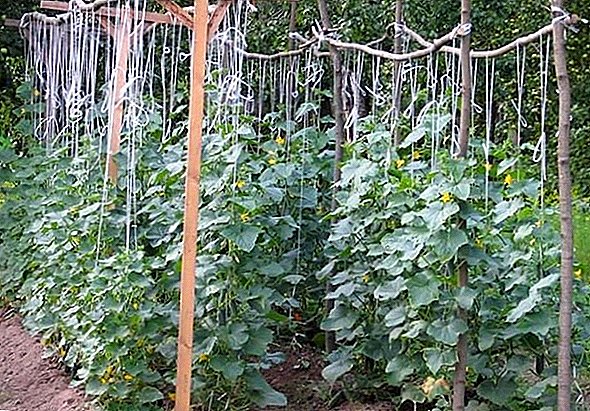
- Grid - the method assumes the presence of a purchase mesh for creeping plants. It personifies a vertical-horizontal support and allows cucumbers to freely traverse in sections. Mesh material can be attached to the supports in any form.

Read how to set the trellis grid for cucumbers.
Top dressing
For abundant fruiting cucumbers need to be fertilized every week, especially if there was no proper preparation of the soil before sowing. For this purpose, gardeners use ready-made organic or mineral complex fertilizers.  The first root dressings are relevant already for a three-week sprouts. Throughout the summer, experienced gardeners advise to alternate the following mixtures:
The first root dressings are relevant already for a three-week sprouts. Throughout the summer, experienced gardeners advise to alternate the following mixtures:
- 2 capsules of Energena are dissolved in a bucket of warm water (for each meter square consumption of growth-stimulating solution is about 3 liters);
- 1 tablespoon of the granulate "Agricol-5" dissolved in a bucket of water (per meter square garden beds will need up to 4 liters of liquid);
- 2 tablespoons of "Effecton-O" stir in a bucket of water (the consumption of liquid organic fertilizer will be about 4 liters per square meter);
- 1 tablespoon of nitrophosphate and 2 tablespoons of the organic liquid "Agricola Vegeta" dissolved in a 10-liter bucket of water (consumption of about 5 liters per m2);
- 2 tablespoons of granules complex mineral fertilizer for cucumbers "Agricola" dissolved in 10 liters of water (solution consumption does not exceed 3 l / m2);
- 3 tablespoons of liquid organic "Agricola Aqua" dissolved in a bucket of water (recommended from the second half of summer to prevent yellowing of foliage, consumption is about 3l / m2).

Pests, diseases and prevention
All cucumbers are to some extent sensitive to a variety of diseases and pests, therefore, in the cultivation of this crop, a special place is given to preventive measures. After all, the slightest mistake in the maintenance and care is not the best way can affect the harvest.
Important! From organic fertilizers, solutions of chicken manure and mullein are most suitable for cucumbers. Keep in mind that in cold weather feeding will be powerless.
Green Stream is a hardy variety and differs from other counterparts in its increased resistance to powdery mildew and peronosporosis. But besides this disease, the plant is to some extent exposed:
- white and root rot;
- anthracnose;
- kladosporiozu;
- melon aphid attacks;
- spider mite;
- slugs;
- ants;
- whitefly.
 Whiteflies With a strong infection, some problems are not always solved. For the purposes of prophylaxis, experienced gardeners advise in a timely manner to remove plant residues from the beds and prevent the growth of weeds. In the autumn it is important to carry out deep processing and fertilizer area. Seeding is very important.
Whiteflies With a strong infection, some problems are not always solved. For the purposes of prophylaxis, experienced gardeners advise in a timely manner to remove plant residues from the beds and prevent the growth of weeds. In the autumn it is important to carry out deep processing and fertilizer area. Seeding is very important.Did you know? The ancient Greeks depicted cucumbers on the frescoes of the oldest shrines. These fruits are recommended as a therapeutic food Feofrast and Dioscorides. And according to the records of Avicenna, greens are especially useful for the prevention of diseases of the stomach and liver, better than others quench thirst, relieve fever.
To save their cucumbers experienced housewives, without waiting for obvious signs of pests, sprinkle the rows with fermented grass. To do this, in a bucket of water insist throughout the day 1 kilogram of fresh hay. Alternatively, you can sprinkle plants with a mixture of 200 g of ash and 50 g of soap chips.  Fermented grass as a fertilizer. If the grandfather's methods do not cope with the task, you will have to resort to agrochemical means. In the fight against various parasitic insects, the following insecticides have proven themselves well:
Fermented grass as a fertilizer. If the grandfather's methods do not cope with the task, you will have to resort to agrochemical means. In the fight against various parasitic insects, the following insecticides have proven themselves well:
- Aktara;
- Actellic;
- "Decis Profi";
- "Calypso";
- "Prestige";
- "Envidor".
 To counter the putrefactive infections and fungal diseases, it is recommended to use fungicides:
To counter the putrefactive infections and fungal diseases, it is recommended to use fungicides:- Teldor;
- Allette;
- "Infinito";
- Coronet;
- "Preikur Yenerzhi".
Did you know? Zelentsy is 95 percent water.
All the proportions of the mentioned chemicals are calculated according to the manufacturer's instructions. Do not forget about the rules of hygiene beds. If the land is already infected on it, generously pour boiling water and a weak solution of potassium permanganate before sowing. In the process of caring for cucumber cucumbers do not allow watering with cold water.  Watering with a weak solution of potassium permanganate Periodically inspect the plants and, as necessary, remove all affected areas of vines. Copies that are not treatable and continue to wither away should be removed from the garden.
Watering with a weak solution of potassium permanganate Periodically inspect the plants and, as necessary, remove all affected areas of vines. Copies that are not treatable and continue to wither away should be removed from the garden.
Harvesting and storage
The peak of fruiting "Green Stream" begins in mid-summer. Note that the hybrid in terms of fruit ripening is considered early, but greens can be harvested from it before the first frost.
Did you know? Slavic peoples engaged in the cultivation of cucumbers from the 16th century.
It is important to pick cucumbers in time. After all, in the form of overgrown, they are not suitable for use. Experienced housewives are advised to harvest every second day. The best time for this is morning. It is noticed that the fruits collected during the day or in the evening are worse stored and lose their specific crunch.  Not only beautiful and even vegetables are subject to harvest, but also bent, defective ones. Consider that each left fruit delays the formation of a new ovary. In the process of work it is impossible to jerk or unscrew the Zelentsy, step on the feet on the fence. The plant is very sensitive to all touches, after that it hurts for a long time.
Not only beautiful and even vegetables are subject to harvest, but also bent, defective ones. Consider that each left fruit delays the formation of a new ovary. In the process of work it is impossible to jerk or unscrew the Zelentsy, step on the feet on the fence. The plant is very sensitive to all touches, after that it hurts for a long time.
It is better to collect the greenhouses with scissors, carefully cutting off the fruit from the creeper. An alternative option for this may be stinging the stem. Once on the garden, do not forget to remove from it the old yellowed fruits and foliage.
Important! Do not overdo it with organic fertilizers. Remember that in their composition can be very tenacious insects and disease-causing microbes.
Fresh green stuff can not be stored for a long time. Maximum 1-2 weeks. You can extend the shelf life for the same period by wrapping the fruit in polyethylene. Some housewives manage to create a bouquet of cucumbers. They are cut off with long stems and put in a saucepan with water. In this form, the crop can remain fresh for another 5 days.
And in the future, the fruit does not avoid canning, pickles and marinades. Just before consumption, it is important to thoroughly wash the entire crop. 
Possible problems and recommendations
Often gardeners are faced with unforeseen problems in the cultivation of cucumbers. It would seem that all agrotechnical requirements are met and the conditions of culture maintenance are taken into account, and the crop is low and the plant looks painful. This is what actually happens with the bushes and common mistakes of gardeners:
- Thickened plantings are doomed to lag in development and poor harvest. Lack of light and poor ventilation contributes to diseases of culture. Therefore, the only way out of this situation is thinning the rows. Indeed, even with the timely detection of the disease and adequate treatment, it will not be possible to save the cucumbers until the main cause of discomfort is resolved.
- Attacks of insects are often triggered by weeds that have grown in the garden. Therefore, strictly follow the recommendations of the cucumber care specialists. This is a very demanding culture. And if you do not appease it, you will not receive a harvest.
- Yellowing foliage, point wilting - these are signs of life activity of sucking parasites. Try to spray the bushes with any insecticide. Sometimes these spots indicate sunburns that appear when covering the planting film. Therefore, in the heat never cover the cucumber patch.
- Young seedlings freeze in growth - such a problem usually appears on areas clogged with unnecessary vegetation. High-quality weeding will solve the problem. It is important to repeat this procedure every time a new weed appears. And overnight, and loosen the earth.
- The ovary is usually showered with an improperly formed bush, when the plant does not have the strength to feed all the branches. Check your landings with our recommendations for staking and the problem will be fixed.
- The fruits rot and scourge. This happens usually if the bushes are not tied to a support. It’s categorically impossible to ignore this requirement, because in this way you are aware that you are depriving yourself of greenberries.
 Hybrid "Green Flow F1" justified the confidence of many gardeners and proved its competitiveness in relation to other varieties. If you take into account all the requirements of the plant, then you can enjoy tasty fruits not only during the whole harvest season, but also in winter. Moreover, the breeders tried their best to facilitate the work of gardeners in a cucumber bed.
Hybrid "Green Flow F1" justified the confidence of many gardeners and proved its competitiveness in relation to other varieties. If you take into account all the requirements of the plant, then you can enjoy tasty fruits not only during the whole harvest season, but also in winter. Moreover, the breeders tried their best to facilitate the work of gardeners in a cucumber bed.Opinions of users about cucumbers "Green Stream"
This variety is a hybrid type. It does not require additional pollination by bees. I like cucumbers for their yield. Up to five cucumbers are formed in one plant node. I sow cucumbers right in the ground of the greenhouse. Part of the seed sowing on the street under the shelter. For reliability of landing I cover with a film from above.
This variety of cucumbers forms powerful stems with a variety of cucumbers on them. Plants I place on the trellis. Tying branches to it. Fruits of cucumbers Green flow have an elongated, cylindrical shape. Their length reaches 13 centimeters. Fruits are dark green in color, with small tubercles on the surface. The fruits are not very large. I have an average weight of cucumbers about 120 grams.
Cucumbers of this variety are juicy and fragrant. I use them for fresh food, add them to salads, salt and preserve. Variety of cucumbers Green stream is a hybrid. Therefore, it is resistant to a number of viral diseases, always gives a good harvest. This variety has one drawback: you can not collect seeds. I like this variety for its yield. With one square meter of cucumber planting, I gathered at least 16 kilograms of fruit.






